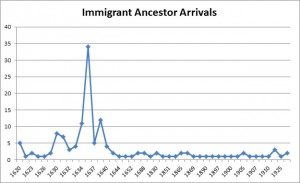As we proceed, we will continue to use this blog for posting general reports and for commenting of things of interest to the Thomas Gardner Society, Inc. The technical blog will be used for those things dealing with the details whether of content, configuration, or other.
---
The following addresses a few things that are of special interest.
- - This year, the Thomas Gardner Society will offer two types of membership: descendant and supporting. The former will offer a means for those who descend from Thomas and Margaret to provide supported documentation of their lineage. We are preparing the application process.
- Those are interested in membership, or in making contribution to the Society, please contact Ann at algswtlk[@]aol[.]com.
 |
| Vita Bevis image Arrival, by year, ancestors of NEHGS staff members |
- - Some NEHGS offerings are of special interest, given that we are working on an application process. For one, a recent video talks about lineage societies and how one applies to them: How to Apply to Lineage Societies: Tips from NEHGS. This can be used as an introduction to the general ideas.
- As an aside, we are going to ask for documentation from the applicant's great-grandparent out. That is, more recent information related to the applicant and spouse(s), the applicant's parents, and the applicant's grandparents ought to be considered private and privileged, and handled thusly. From what we have seen (to be discussed) so far (many applications), we wonder just how respectful are these storage methods.
- There is much to discuss, but those pieces of recent information ought to be collected and verified once. By whom and how? Then, whoever might need the information would get redacted results. There are (ought to be) ongoing discussions on this matter.
- So, the applicant can expect to offer a lineage from about three generations out to Thomas and Margaret. We will collect these into a fully-sourced, accessible, document (technical choices under review).
- Prior to submitting an application, though, one needs to have details about one's lineage and its acceptability. We will address this further (technical post, soon). However, R.C. Anderson, recently, published a book on his methods (Elements of Genealogical Analysis) that were developed through the Great Migration effort.
- - The technical post (see Remarks, 10/31/2014) mentioned in the prior bullet will deal with the format for supporting documentation. We, personally, have submitted packets of 50+ pages in support of applications (with some complaining of the size - however, one genealogist did say that the application that we have submitted was one of the best that he has seen in terms of supporting material presenting a cogent story).
- At the same time, an organization that allows use of another society's information can result in a much smaller packet. For one example that we can show, a D.A.R. Record Copy can replace 17 pages. In the 50+ case, that would leave 33+. For some reason, many genealogists don't seem to trust others (this is something to analyze, to boot).
- On the other hand, we can also show an application with a mere 7 pages with the D.A.R. Record Copy. That later case may be too small, but not if it references easily accessible information. The support material, essentially, consisted of links to on-line material with a small snap-shot from each source.
- Silly? No. Let's use Rich Hall's work (see below). He has the "famouskin" site (take off on some works by G.B. Roberts of NEHGS) which shows how celebrity and its attention motivate filling in genealogical pieces. So, finding famous cousins may offer help to researchers. we have found it to be so.
- That is, have you not heard that the rich and famous get the genealogical attention? Or, the corollary? Many with pedigrees have been ignored due to several reasons, such as lack of resources, nobody interested, etc.
- So, take this example, please. We'll use Edith (Carow) Roosevelt. She is a Thomas descendant (see above NEHGS link, plus Gardner's Beacon, Vol. IV, No. 3). Let's see how Edith relates to Sir George Downing. There are other examples, but we picked George as his sister, Ann, married Joseph Gardner.
- In the top box of the Edith graph, mouse-over either Emanuel Downing or Lucy Winthrop. Notice the drop-down menu. Also, notice that you can transition over to a lot of the sources and read the material. That will be a focus of the presentation that we expect to pursue.
- - Now, having said that about sources (prior bullet), we will use the ahnentafel of Lucy Foster Wilson Gardner who was the grandmother of Dr. Frank A. as the means to demonstrate the ideas. There are many ways to approach the task, but we will convert the PDF material to a linked HTML file. Notice that the ahnentafel is fully sourced with footnotes. Just about all of those source references are to on-line material.
- ---
Remarks: Modified: 11/13/2024
10/28/2014 - The 400th anniversaries are a more remote focus.
10/31/2014 - See start of technical discussion: Supporting material.
03/02/2019 -- We're build an index via images at our portal to truth.
08/04/2020 -- Updated the link for the image of arrivals of ancestors for the staff.
11/13/2024 -- Updated the link, again, for the image of arrivals of ancestors for the staff (Mayflower context).
No comments:
Post a Comment